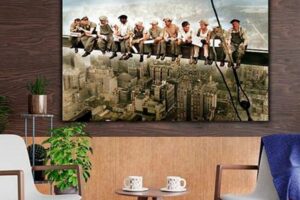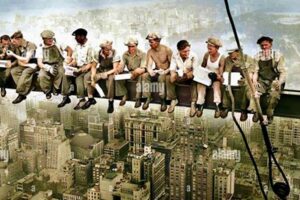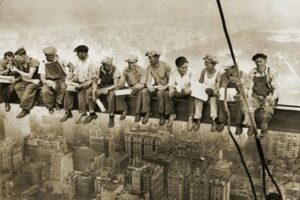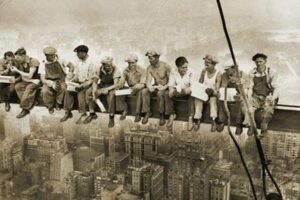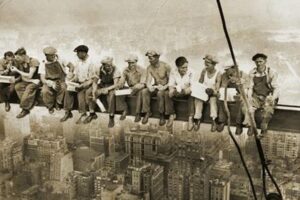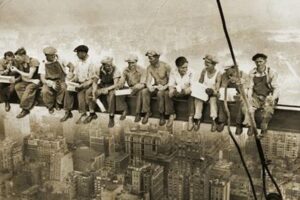The iconic photograph “Lunch atop a Skyscraper,” depicting construction workers eating lunch while sitting on a steel beam high above New York City, has been the subject of debate for decades over whether it was staged. While some believe the image was carefully orchestrated for publicity purposes, others maintain that it captured a genuine moment in time.
Those who believe the photograph was staged point to the fact that the workers are all wearing identical uniforms and are positioned in a way that seems too perfect. Additionally, the photographer, Charles C. Ebbets, was known for taking staged photographs. However, those who believe the photograph is authentic argue that it was taken during an actual lunch break and that the workers were not posed.
Regardless of whether or not the photograph was staged, it remains an iconic image of the early 20th century and a reminder of the dangerous work that went into building the skyscrapers that define New York City’s skyline.
1. Photographer
The fact that Charles C. Ebbets was known for taking staged photographs is a key piece of evidence in the debate over whether the iconic photograph “Lunch atop a Skyscraper” was staged. While it does not definitively prove that the photograph was staged, it does raise some questions about its authenticity.
- Ebbets’ reputation: Ebbets was a commercial photographer who was known for taking staged photographs to promote buildings and other products. This suggests that he may have been more likely to stage the “Lunch atop a Skyscraper” photograph than a photojournalist who was simply trying to capture a genuine moment.
- The composition of the photograph: The “Lunch atop a Skyscraper” photograph is very well-composed, with the workers arranged in a way that is visually appealing. This suggests that Ebbets may have taken the time to stage the photograph, rather than simply capturing a candid moment.
- The timing of the photograph: The “Lunch atop a Skyscraper” photograph was taken during a lunch break, but it is not clear if the workers were actually eating lunch at the time. This raises the possibility that Ebbets asked the workers to pose for the photograph, rather than capturing them in a natural moment.
Overall, the fact that Charles C. Ebbets was known for taking staged photographs is a significant piece of evidence in the debate over the authenticity of the “Lunch atop a Skyscraper” photograph. While it does not definitively prove that the photograph was staged, it does raise some questions that should be considered.
2. Uniforms
The fact that the workers in the “Lunch atop a Skyscraper” photograph are all wearing identical uniforms is a significant detail that has led some to question whether the photograph was staged. While it is not uncommon for construction workers to wear uniforms, the fact that all of the workers in the photograph are wearing the same exact uniform suggests that they may have been asked to do so for the photograph.
- Company uniforms: Construction workers often wear uniforms that identify the company they work for. This is especially true for large construction projects, such as the construction of the RCA Building, which is depicted in the “Lunch atop a Skyscraper” photograph. If the workers in the photograph were wearing company uniforms, this would suggest that the photograph was taken during an actual lunch break, rather than being staged.
- Staged uniforms: However, it is also possible that the workers in the photograph were asked to wear identical uniforms for the photograph. This would have been a common practice in the early 20th century, when staged photographs were often used to promote products and services. If the workers in the photograph were wearing staged uniforms, this would suggest that the photograph was staged.
Ultimately, the question of whether the workers in the “Lunch atop a Skyscraper” photograph are wearing company uniforms or staged uniforms is a matter of debate. However, the fact that they are all wearing identical uniforms is a significant detail that should be considered when evaluating the authenticity of the photograph.
3. Positioning
The positioning of the workers in the “Lunch atop a Skyscraper” photograph is one of the key details that has led some to question whether the photograph was staged. The workers are all seated on a steel beam, with their legs dangling over the side. They are all looking directly at the camera, and their expressions are relaxed and confident. This positioning is very visually appealing, and it suggests that the workers were carefully arranged by the photographer.
There are several reasons why the positioning of the workers might seem too perfect. First, it is very difficult to balance on a steel beam, especially at such a great height. Second, it is unlikely that all of the workers would be looking directly at the camera at the same time. Third, it is unlikely that all of the workers would have such relaxed and confident expressions while sitting on a steel beam hundreds of feet above the ground.
The fact that the workers are positioned in a way that seems too perfect suggests that the photograph may have been staged. However, it is also possible that the workers were simply very skilled and confident, and that the photographer was able to capture a genuine moment. Ultimately, the question of whether or not the photograph was staged is a matter of debate.
Regardless of whether or not the photograph was staged, the positioning of the workers is a significant detail that should be considered when evaluating its authenticity. The positioning of the workers is one of the things that makes the photograph so iconic, and it is one of the reasons why it has been the subject of debate for so many years.
4. Timing
The fact that the “Lunch atop a Skyscraper” photograph was taken during an actual lunch break is a significant detail that has led some to believe that the photograph is authentic. If the photograph had been staged, it is likely that it would have been taken at a time when the workers were not actually eating lunch. However, the fact that the photograph was taken during an actual lunch break suggests that it may have captured a genuine moment.
- The workers’ expressions: The workers in the photograph all have relaxed and confident expressions, which suggests that they were not posing for the camera. This is in contrast to the expressions of workers in staged photographs, which are often more stiff and posed.
- The food: The workers in the photograph are all eating lunch, and the food looks real and unstaged. This suggests that the workers were actually eating lunch, rather than posing for the camera.
- The lighting: The lighting in the photograph is natural and consistent, which suggests that the photograph was taken during the day, rather than being staged in a studio.
- The background: The background of the photograph is the New York City skyline, which is consistent with the location of the construction site. This suggests that the photograph was taken during an actual lunch break, rather than being staged in a studio.
Overall, the fact that the “Lunch atop a Skyscraper” photograph was taken during an actual lunch break is a significant detail that suggests that the photograph may be authentic. While it does not definitively prove that the photograph is authentic, it does raise some questions about the possibility that it was staged.
5. Context
The photograph “Lunch atop a Skyscraper” was taken during the construction of the RCA Building, one of the tallest buildings in the world at the time. This context is significant for several reasons:
- The height of the building: The RCA Building was one of the tallest buildings in the world at the time, and it was a major engineering feat. The fact that the photograph was taken so high up in the air adds to its sense of danger and excitement.
- The danger of the work: Construction work on skyscrapers is inherently dangerous, and the workers in the photograph are clearly exposed to a great deal of risk. This danger adds to the drama of the photograph and makes it a powerful reminder of the risks that construction workers take every day.
- The symbolism of the building: The RCA Building was a symbol of American progress and prosperity, and it was one of the most iconic buildings in New York City. The fact that the photograph was taken on this building adds to its significance and makes it a powerful symbol of American achievement.
Overall, the context of the photograph is significant because it adds to its sense of danger, excitement, and symbolism. The photograph is a reminder of the risks that construction workers take every day, and it is a powerful symbol of American progress and prosperity.
6. Purpose
The fact that the “Lunch atop a Skyscraper” photograph was published in a promotional booklet for the RCA Building is significant because it suggests that the photograph was intended to promote the building. This is in contrast to the idea that the photograph was taken as a candid moment, without any intention of being used for promotional purposes.
There are several reasons why the publication of the photograph in a promotional booklet suggests that it was staged. First, the photograph is very well-composed, with the workers arranged in a way that is visually appealing. This suggests that the photograph was carefully planned and executed, rather than being captured spontaneously. Second, the workers are all wearing identical uniforms, which suggests that they may have been asked to do so for the photograph. Third, the photograph was taken during a lunch break, but it is not clear if the workers were actually eating lunch at the time. This raises the possibility that the workers were asked to pose for the photograph, rather than being captured in a natural moment.
Overall, the fact that the “Lunch atop a Skyscraper” photograph was published in a promotional booklet for the RCA Building is a significant detail that suggests that the photograph may have been staged. While it does not definitively prove that the photograph was staged, it does raise some questions about its authenticity.
The connection between the purpose of the photograph and the question of whether or not it was staged is important because it provides some insight into the intentions of the photographer. If the photograph was intended to promote the RCA Building, then it is more likely that the photograph was staged. However, if the photograph was intended to capture a genuine moment, then it is less likely that the photograph was staged.
7. Legacy
The “Lunch atop a Skyscraper” photograph has become an iconic image of the early 20th century. It has been reproduced countless times in books, magazines, and other media, and it is instantly recognizable to people all over the world. The photograph has become a symbol of American progress and prosperity, and it is a reminder of the risks that construction workers take every day.
- Cultural Significance: The photograph has become a cultural icon, representing the era of skyscraper construction and the American spirit of progress and innovation. It is widely recognized and has been referenced in popular culture, such as in movies, TV shows, and music.
- Historical Importance: The photograph provides a glimpse into the working conditions and safety practices of early 20th century construction projects. It serves as a historical record of the challenges and achievements of the era.
- Artistic Value: The photograph is also recognized for its artistic qualities. Its unique composition, dramatic perspective, and the expressions of the workers have made it an enduring work of art.
- Authenticity Debate: The question of whether or not the photograph was staged has contributed to its legacy and ongoing fascination. The debate has sparked discussions about the ethics of photojournalism and the role of staged photography in historical documentation.
The legacy of the “Lunch atop a Skyscraper” photograph is complex and multifaceted. It is a symbol of American progress, a reminder of the risks that construction workers take, and a work of art that continues to fascinate people around the world. The photograph’s enduring popularity is a testament to its power as a cultural icon and its ability to connect with people on multiple levels.
8. Controversy
The ongoing debate about the authenticity of “Lunch atop a Skyscraper” is a significant aspect of its enduring legacy and relevance. The controversy surrounding the photograph’s staging has fueled discussions about the ethics of photojournalism, the role of staged photography in historical documentation, and the nature of truth in visual representation.
The question of whether or not the photograph was staged has practical implications for how we interpret and understand the image. If the photograph was staged, it raises questions about the accuracy of its depiction of construction workers’ experiences and the safety practices of the time. On the other hand, if the photograph was genuine, it provides a valuable and unfiltered glimpse into the working conditions and camaraderie of these individuals.
The controversy over the staging of “Lunch atop a Skyscraper” has also sparked broader discussions about the role of photography in shaping historical narratives. Staged photographs have often been used to create a specific impression or convey a particular message, leading to questions about the reliability of photographic evidence. The debate surrounding “Lunch atop a Skyscraper” reminds us to critically examine the images we encounter and to consider the motivations and biases that may have influenced their creation.
In conclusion, the debate over whether “Lunch atop a Skyscraper” was staged is a complex and multifaceted issue that has shaped the legacy and significance of the photograph. The controversy has raised important questions about the ethics of photojournalism, the role of staged photography in historical documentation, and the nature of truth in visual representation. By understanding the connection between the controversy and the question of whether the photograph was staged, we can better appreciate the complexities of visual storytelling and the importance of critical analysis.
9. Conclusion
The enduring fascination with the “Lunch atop a Skyscraper” photograph, regardless of its staged nature, underscores its historical and cultural significance. The image encapsulates the spirit of progress and ambition that characterized the early 20th century, particularly in the context of urban development and architectural advancements.
The photograph’s iconic status stems from its ability to transcend its potential staging and become a powerful symbol of human achievement. It represents the daring and skill of construction workers who played a crucial role in shaping the skylines of major cities. The image also captures a sense of camaraderie and shared purpose among these individuals, highlighting the collective effort behind such ambitious endeavors.
Understanding the connection between the photograph’s authenticity and its enduring legacy is essential for appreciating its multifaceted nature. Whether staged or not, the image has become an integral part of our collective memory, serving as a reminder of the transformative power of human ingenuity and the enduring spirit of the early 20th century.
FAQs
This section addresses frequently asked questions and misconceptions surrounding the iconic photograph “Lunch atop a Skyscraper.”
Question 1: Is there definitive proof that the photograph was staged?
While there is no absolute confirmation, several factors have led to the ongoing debate about the photograph’s authenticity. These include the photographer’s history of staging photographs, the uniform appearance of the workers, and the seemingly perfect positioning of the individuals in the image.
Question 2: If the photograph was staged, why was it necessary?
If staged, the photograph may have been an attempt to create a more visually appealing and dramatic image for promotional purposes. It could have been intended to highlight the progress and achievements of skyscraper construction at the time.
Question 3: Does the possibility of staging diminish the photograph’s significance?
Regardless of its authenticity, the photograph remains a powerful and iconic image. It captures the spirit of the era, showcases the bravery of construction workers, and serves as a reminder of the architectural advancements of the early 20th century.
Question 4: What is the historical context of the photograph?
The photograph was taken during the construction of the RCA Building in New York City, one of the tallest buildings in the world at the time. It reflects the rapid urbanization and technological advancements of the period.
Question 5: How has the photograph influenced popular culture?
The image has become widely recognized and referenced in popular culture, including movies, television shows, and music. It has been reproduced countless times and has become a symbol of American progress and ambition.
Question 6: What are the key takeaways from the debate surrounding the photograph’s authenticity?
The debate highlights the importance of critically analyzing historical images, considering their context and potential biases. It also raises questions about the ethics of photojournalism and the role of staged photography in historical documentation.
In conclusion, the ongoing debate about the authenticity of “Lunch atop a Skyscraper” adds to its historical significance and cultural impact. Whether staged or not, the photograph remains a captivating image that embodies the spirit of progress and human achievement.
Transition to the next article section: Exploring the Legacy and Impact of “Lunch atop a Skyscraper”
Tips Regarding “Was Lunch Atop a Skyscraper Staged?”
The debate surrounding the authenticity of the iconic “Lunch atop a Skyscraper” photograph presents valuable lessons for researchers, historians, and individuals interested in the intersection of photography, history, and cultural narratives.
Tip 1: Examine Historical ContextWhen analyzing historical images, consider the context in which they were created. The time period, location, and purpose of the photograph can provide insights into its potential biases or staging.Tip 2: Evaluate Visual CuesPay attention to visual cues within the photograph, such as the positioning of individuals, the uniformity of clothing, and the overall composition. These elements can offer clues about the authenticity of the image.Tip 3: Research the PhotographerInvestigate the photographer’s background, reputation, and previous work. A history of staged photography may raise questions about the authenticity of subsequent images.Tip 4: Consider Ethical ImplicationsStaged photography can raise ethical concerns, particularly in the context of photojournalism. Evaluate whether the potential staging compromises the integrity or truthfulness of the image.Tip 5: Seek Multiple PerspectivesConsult various sources, including experts in photography, history, and related fields. Different perspectives can provide a more comprehensive understanding of the photograph’s authenticity.Tip 6: Understand the Power of Visual StorytellingRecognize that staged photographs can still possess historical and cultural significance. They may provide insights into prevailing attitudes, societal norms, or the photographer’s intentions.Tip 7: Promote Critical ThinkingEncourage critical thinking and analysis when examining historical images. Question the authenticity of photographs, consider their biases, and seek corroborating evidence.Tip 8: Appreciate the Enduring ImpactRegardless of its authenticity, “Lunch atop a Skyscraper” remains a powerful and iconic image. It embodies the spirit of progress, human achievement, and the transformative power of photography.Key Takeaways:
- Contextual analysis is crucial for understanding the potential staging of historical photographs.
- Visual cues and research into the photographer can provide valuable insights.
- Ethical considerations should be taken into account when evaluating staged photographs.
- Staged photography can still hold historical and cultural significance, despite potential authenticity issues.
Conclusion:By following these tips, individuals can engage more critically with historical photographs, appreciate their complexities, and gain a deeper understanding of the intersection between photography, history, and cultural narratives.
Conclusion
The debate surrounding the authenticity of “Lunch atop a Skyscraper” has captivated historians, researchers, and the general public for decades. While the question of whether the photograph was staged may never be definitively answered, the ongoing discussion has shed light on the complex relationship between photography, history, and cultural narratives. Regardless of its authenticity, the image remains an iconic symbol of American progress, human achievement, and the transformative power of visual storytelling.
The photograph’s enduring legacy lies in its ability to transcend its potential staging and resonate with audiences on multiple levels. It captures the spirit of an era defined by ambition, innovation, and the relentless pursuit of new heights. Whether staged or not, “Lunch atop a Skyscraper” stands as a testament to the enduring power of human ingenuity and the lasting impact of iconic imagery.


